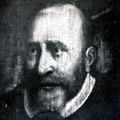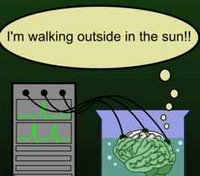Friday, March 30, 2007
List of people who went to heaven alive

The concept of humans directly entering heaven without dying is a feature of multiple religions and mythic traditions, including the three main Abrahamic religions – Judaism, Christianity, Islam. Since death is generally considered the normal end to an individual's life on earth, entering heaven without dying first is considered exceptional and usually a sign of God's special recognition of the individual's piety.
According to the Jewish Midrash, nine people went to heaven (also referred to as the Garden of Eden and Paradise) alive. Elijah the Prophet "went up by a whirlwind into heaven" (Kings II Chapter 2, Verse 11). Serach, the daughter of Asher - one of the sons of Jacob (Midrash Yalkut Shimoni (Yechezkel 367)). Enoch went to heaven alive (Genesis 5:22-24). This article is licensed under the GNU Free Documentation License. It uses material from the Wikipedia article "List of people who went to heaven alive". This entry is a fragment of a larger work. Link may die if entry is finally removed or merged.
Tuesday, March 27, 2007
The Bikini Carwash Company

The Bikini Carwash Company is a movie that was directed by Ed Hansen and released in 1992. It featured Joe Dusic, Kristi Ducati, and Ricki Brando.
In the film, a group of young women decide to help out a local carwash by wearing bikinis while they wash the customers' cars. This succeeds in attracting more customers, more money, and more attention from the police, who are not amused by the scantily-dressed employees! The sequel, The Bikini Carwash Company II, was released in 1993. This article is licensed under the GNU Free Documentation License. It uses material from the Wikipedia article "The Bikini Carwash Company". This entry is a fragment of a larger work. Link may die if entry is finally removed or merged.
Saturday, March 24, 2007
Benzedrine in popular culture

Benzedrine is the trade name of the racemic variant of amphetamine (dl-amphetamine). It was marketed under this brandname in the USA by Smith, Kline and French in the form of inhalers, starting in 1928. Benzedrine was used to enlarge nasal and bronchial passages and it is closely related to other stimulants produced later, such as Dexedrine (d-amphetamine) and methamphetamine.
References in popular culture: This drug was very popular with the beat generation and its influence can be seen in the literature and biographies of William S. Burroughs, Jack Kerouac and Allen Ginsberg. Also, a famous user was the prolific mathematician Paul Erdős, who spent much of his restless life on psychostimulants. An article of November 1987, published in the Atlantic Monthly profiled Erdős and discussed his Benzedrine habit. Erdős said to writer Paul Hoffman that he had liked the article "...except for one thing...You shouldn't have mentioned the stuff about Benzedrine. It's not that you got it wrong. It's just that I don't want kids who are thinking about going into mathematics to think that they have to take drugs to succeed."
Former Beach Boy Brian Wilson claims that many of the songs on his album Smile were written while the lyricist Van Dyke Parks was under the influence of Benzedrine. The Beatles have said that in their early days in Hamburg, Germany, they used Benzedrine quite often in order to play several concerts a night without getting sleepy. Benzedrine was given to Judy Garland at a young age to help with her weight. She became dependent on the drug for the rest of her life. Benzedrine is the preferred drug of choice amongst the flawed characters which make up the noir fiction of James Ellroy, who himself has confessed a past addiction to the drug. This article is licensed under the GNU Free Documentation License. It uses material from the Wikipedia article "Benzedrine in popular culture". This entry is a fragment of a larger work. Link may die if entry is finally removed or merged.
Thursday, March 22, 2007
List of people with fear of flying

A list of famous people who suffer or have suffered from Aviophobia, the fear of flying in an aeroplane or helicopter.
Real people: Isaac Asimov, Dennis Bergkamp, Kate Bush, Gene Clark, Elisha Cuthbert, Doris Day, Brandon DiCamillo, Aretha Franklin, Jackie Jensen, Tony Kornheiser, Stanley Kubrick, Kim Jong-Il, Matthew Sweet, John Madden
Fictional characters: Jonathan "The Duke" Mardukas: Charles Grodin's character in Midnight Run. He claims to have this phobia, among others.
B. A. Baracus of the TV series The A-Team. He is often drugged or otherwise knocked out by his friends so that they can get him onto a plane.
Adrian Monk from the TV series Monk. He did achieve getting on a plane by the end of the first season however. Carla Tortelli from the TV series Cheers. John Doe from the TV series John Doe. Raymond Babbitt in the 1988 film Rain Man. An autistic man who refuses to fly on any airline for fear of it crashing--except Qantas, which he claims has never had a crash.
Alex Browning from the film Final Destination. Wendell Urth, a housebound detective created by, and sharing his fears with, Isaac Asimov. Jack Ryan, protagonist of most novels by Tom Clancy. Marge Simpson , although she later overcame her fear of flying, before being involved in a minor air crash. (Episode 2F08, "Fear of Flying") Maris Crane, of Frasier, due to a bad experience of being "bumped" from first class. Father Ted from the TV series Father Ted. Tyler from the 2006 movie Snakes on a Plane. This article is licensed under the GNU Free Documentation License. It uses material from the Wikipedia article "List of people with fear of flying". This entry is a fragment of a larger work. Link may die if entry is finally removed or merged.
Monday, March 19, 2007
Twinkies in popular culture

The Twinkie snack food cake, ubiquitous in the United States, has made many appearances in modern media. Some examples include:
- Twinkies are the popular Over the Hedge comic book character, R.J's favorite food to eat.
- The Twinkies is a popular and often-used nickname for the Minnesota Twins baseball team.
- A Twinkie is used by Egon Spengler in the first Ghostbusters movie, to illustrate the severity of ghostly activity in New York City: "Well, let's say this Twinkie represents the normal amount of psychokinetic energy in the New York area. Based on this morning's reading, it would be a Twinkie thirty-five feet long, weighing approximately six hundred pounds."
"That's a big Twinkie."
Urban Legend: An urban legend holds that twinkies are chemically synthesized and require no baking. As a result, they supposedly have a nearly limitless shelf-life and could potentially "survive a nuclear war" (like cockroaches). Freshness is guaranteed only for about 25 days, leading some urban myth experts to believe it is false. They do last longer than most other baked goods due to the fact that the filling is not actually dairy. However, some science teachers have kept Twinkies since 1998 which show no signs of deterioration.This article is licensed under the GNU Free Documentation License. It uses material from the Wikipedia article "Twinkies in popular culture". This entry is a fragment of a larger work. Link may die if entry is finally removed or merged.
Saturday, March 17, 2007
1/4 + 1/16 + 1/64 + 1/256 + · · ·

In mathematics, the infinite series 1/4 + 1/16 + 1/64 + 1/256 + ... is an example of one of the first infinite series to be summed in the history of mathematics; it was used by Archimedes circa 250-200 BC. Its sum is 1/3.
References: Shawyer, Bruce and Bruce Watson (1994). Borel's Methods of Summability: Theory and Applications. Oxford UP. ISBN 0-19-853585-6., Stein, Sherman K. (1999). Archimedes: What Did He Do Besides Cry Eureka?. MAA. ISBN 0883857189, Ajose, Sunday and Roger Nelsen (June 1994). "Proof without Words: Geometric Series". Mathematics Magazine 67 (3): 230, Mabry, Rick (February 1999). "Proof without Words: 1⁄4 + (1⁄4)2 + (1⁄4)3 + · · · = 1⁄3". Mathematics Magazine 72 (1): 63; Text of Quadrature of the Parabola with commentary. This article is licensed under the GNU Free Documentation License. It uses material from the Wikipedia article "1/4 + 1/16 + 1/64 + 1/256 + · · ·". This entry is a fragment of a larger work. Link may die if entry is finally removed or merged.
Wednesday, March 14, 2007
Danielle Rousseau

Danielle Rousseau, often referred to as "the French woman", is a fictional character on the ABC television series Lost played by Mira Furlan. She is a recurring on-island character who has appeared periodically throughout seasons one through three. She has lived on the island for 16 years, crash landed with her science team while investigating a mysterious signal they picked up at sea.
At the time, of the crash, Rousseau was pregnant, and gave birth to a baby girl she named Alex, but she was abducted by the Others soon after. The rest of her team died in an area she referred to as "the dark territory," including Montand, who lost his arm, and Robert, her lover whom she killed because he had "the sickness." She changed the radio tower's signal from repeating the Numbers (4 8 15 16 23 42) to a distress signal that the survivors heard in "Pilot (Part 2)." This article is licensed under the GNU Free Documentation License. It uses material from the Wikipedia article "Danielle Rousseau". This entry is a fragment of a larger work. Link may die if entry is finally removed or merged.
Sunday, March 11, 2007
TV Guide's 50 Greatest TV Shows of All Time

The 50 Greatest TV Shows of All Time is a list of American TV series compiled by TV Guide as a cover story for the week of May 4, 2002. At the time, TV Guide billed the list as a perspective of the most "influential" television programs in American history. Here is a [truncated] list:
10. Saturday Night Live (NBC, 1975— )
9. The Andy Griffith Show (CBS, 1960–1968)
8. The Simpsons (Fox, 1989— )
7. The Late Show with David Letterman (CBS, 1993— )
6. 60 Minutes (CBS, 1968— )
5. The Sopranos (HBO, 1999–2007)
4. All in the Family (CBS, 1971–1979)
3. The Honeymooners (CBS, 1955–1956)
2. I Love Lucy (CBS, 1951–1957)
1. Seinfeld (NBC, 1989–1998)
Friday, March 09, 2007
Nudity in Judaism

In Judaism and in Jewish communities, men and women use ritual baths called mikvahs for a variety of reasons, mostly religious in the present day. Immersion in a mikvah requires that water covers the entire body (including the entire head). To make sure that water literally touches every part of the body, all clothing, jewelry and even bandages must be removed. In contemporary mikvahs for women, there is always an experienced attendant, commonly called the "mikvah lady", to watch the immersion and ensure that the women have been entirely covered in water.
At the same time, religious Jews are very protective about their naked body. Under the laws of tznius (modesty), both men and women cannot reveal the body parts considered to have sexual connotation (including upper arms, collarbones, legs, and -- for married women and all men -- hair, which is covered completely or partially). It is postulated in the Shulchan Aruch (the Code of Law) that one must uncover as little body as possible when in the toilet room and even when changing before sleep (trousers are often taken off and exchanged for the pijamas under the covers). By Jewish law, no clothes or jewelry at all can be present during sex; at the same time, it must be done completely under covers, and in complete darkness. This ensures maximum acuteness of the sensation experienced during sex and also decreases the risk of self-awareness and shame about one's body.
See also: Social nudity, Nudity in religion, Social nudity and Christianity, History of nudity, Israeli Naturist Society, Israel's first Naturism Portal, Israel Naturist Home Page, Religious Tolerance: Nudity as mentioned in the Bible. This article is licensed under the GNU Free Documentation License. It uses material from the Wikipedia article "Nudity in Judaism". This entry is a fragment of a larger work. Link may die if entry is finally removed or merged.
Tuesday, March 06, 2007
Zenzizenzizenzic

Zenzizenzizenzic is the eighth power or exponent of a number. For example the zenzizenzizenzic of 2 is 256. It was suggested by Robert Recorde, a 16th century Welsh writer of popular mathematics textbooks, in The Whetstone of Witte, published in 1557, although his spelling was zenzizenzizenzike. It is obsolete except as a curiosity; the Oxford English Dictionary has only one citation for it. It survives as an historical oddity.
The root word is the German zenzic from the Italian censo, meaning "squared."
It dates from a time when there was no easy way of denoting the powers of numbers except as squares and cubes. The fourth power was represented by the square of a square, zenzizenzic, which is a condensed form of the Italian censo di censo, used by Leonardo of Pisa in his famous book Liber Abaci of 1202. The eighth power is by extension zenzizenzizenzic. Similarly the sixth power would be zenzicube, the square of a cube. Zenzizenzizenzic has more Z's than any other known word in the English language. Reference: Entry at Weird Words. This article is licensed under the GNU Free Documentation License. It uses material from the Wikipedia article "Zenzizenzizenzic". Link may die if entry is finally removed or merged.
Sunday, March 04, 2007
List of Mother Pornstars

List of mother porn stars who are married or not married or divorced or dead [partial list]:
Aja: (two children); Alana Evans: divorced (1 child) ; Alexis Fire: (2 children); Alicia Rhodes; Alison Kilgore (Allison Kilgore): (girl 15 years and son 12 years on 2006); Angel Dark (Esmerelda, Esmeralda, Angel, Viktoria, Dark Angel, Pauline, Paulin): a son; Angel Kelly: (Have children); Angela D'Angelo: (her daughter is pornstar: Ice D'Angelo aka Ice LaFox); Angelica; Angelica Sin; Anna Nova; Annette Haven; April Flowers (Aprik, April Summers, April Rain, April): (1 kid); Ariana: married (one son born 1987); Asia Carrera: married (1 daughter); Autumn Haze: (3 children). This article is licensed under the GNU Free Documentation License. It uses material from the Wikipedia article "List of Mother Pornstars". This entry is a fragment of a larger work. Link may die if entry is finally removed or merged.
Thursday, March 01, 2007
Brain in a Vat

In philosophy, the brain in a vat is any of a variety of thought experiments intended to draw out certain features of our ideas of knowledge, reality, truth, mind, and meaning. It is drawn from the idea, common to many science fiction stories, that a mad scientist might remove a person's brain from the body, suspend it in a vat of life-sustaining liquid, and connect its neurons by wires to a supercomputer which would provide it with electrical impulses identical to those the brain normally receives. According to such stories, the computer would then be simulating a virtual reality (including appropriate responses to the brain's own output) and the person with the "disembodied" brain would continue to have perfectly normal conscious experiences without these being related to objects or events in the real world.
The simplest use of brain-in-a-vat scenarios is as an argument for philosophical skepticism and Solipsism. A simple version of this runs as follows: Since the brain in a vat gives and receives the exact same impulses as it would if it were in a skull, and since these are its only way of interacting with its environment, then it is not possible to tell, from the perspective of that brain, whether it is in a skull or a vat. Yet in the first case most of the person's beliefs may be true (if he believes, say, that he is walking down the street, or eating ice-cream); in the latter case they are false. Since, the argument says, you cannot know whether you are a brain in a vat, then you cannot know whether most of your beliefs might be completely false. Since, in principle, it is impossible to rule out your being a brain in a vat, you cannot have good grounds for believing any of the things you believe; you certainly cannot know them. -- This article is licensed under the GNU Free Documentation License. It uses material from the Wikipedia article "Brain in a Vat". This entry is a fragment of a larger work. Link may die if entry is finally removed or merged.
 The Wikipedia Knowledge Dump (WikiDumper.org)
The Wikipedia Knowledge Dump (WikiDumper.org)

